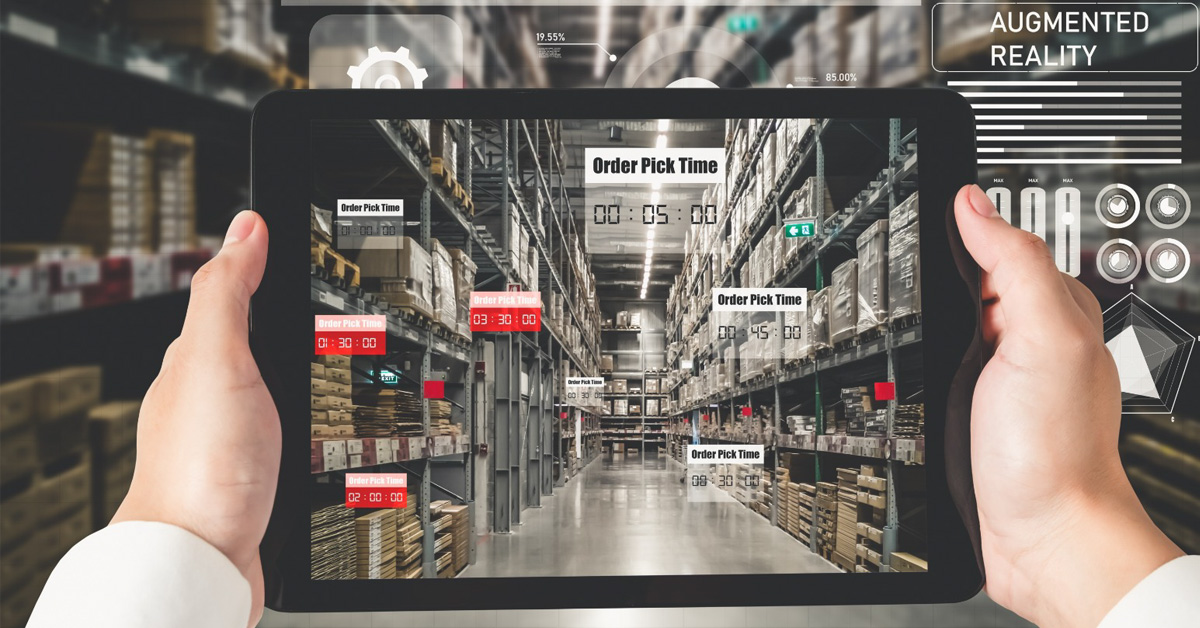
Supply chain management is undergoing a profound digital transformation, one that is accelerating and offering unprecedented access to data. As technology continues to revolutionise the industry, businesses must adapt to new trends and strategies to remain competitive. The challenge is knowing where to start and how to develop a digital supply chain strategic mindset. The COVID-19 pandemic has only accelerated this shift towards digitisation. Faced with restricted movement and evolving channels for customer engagement, businesses have had to double down and quickly innovate with tech solutions during the last few years to stay competitive, such as with the use of autonomous technologies.
However, this digital transformation is not just a peripheral improvement but a central driver of change that is revolutionising the entire supply chain landscape. From financing and procurement, to warehousing and delivery, technology is transforming each stage of the process, paving the way for new trends and strategies to emerge. The transformative impact of technology demands a strategic mindset that is adaptive and forward-thinking. Investing in training and development programs can help professionals acquire the knowledge and skills needed to navigate the complexities of the digital supply chain. The benefits of upskilling and reskilling extend beyond just career advancement, enabling professionals to cultivate a deeper understanding of the industry and to play an active role in shaping its future. In this article, we will explore six of these emerging trends that are shaping the outlook of digital supply chain management and highlight how they are transforming the industry, enabling businesses to operate more effectively and efficiently.
Here are six trends to watch:
1. End-to-end Supply Chain Visibility
Digital transformation is changing the supply chain management landscape, and one of the most critical trends is the increasing use of end-to-end supply chain visibility. This trend is transforming the way businesses operate by enabling them to track and monitor their products' movement from the sourcing of raw materials to the end consumer. With end-to-end supply chain visibility, businesses can gain real-time insights into their supply chain operations, identify inefficiencies and bottlenecks, and reduce costs. By having a clear view of their products' location and status at any point in the supply chain, businesses can proactively identify and resolve issues that could potentially cause disruptions, delays, or quality problems.
The Internet of Things (IoT) has emerged as a game-changing technology for end-to-end supply chain visibility. By leveraging IoT, supply chain managers can improve their operational efficiency, enhance forecasting accuracy, and gain greater visibility into their distribution networks. For instance, fleet managers can utilise IoT-enabled sensors to track the location and condition of goods in transit, optimise delivery routes, and monitor the performance of delivery vehicles in real-time.
One notable example of IoT in supply chain management is Walmart's effective use of RFID tags in tracking inventory which has typically delivered better than 97% inventory accuracy. By tracking products' movement from the warehouse to store shelves and eventual sale, Walmart achieved a procurement transformation that optimised its inventory, leading to efficient procurement and higher customer satisfaction. The ripple effect of RFID's impact includes freeing up time from inquiries, more sales to meet demand, and more precise reporting.
However, according to a survey by supply chain management company Geodis, more than 50% of companies lack end-to-end visibility into their supply chains. While 31% of companies see real-time visibility as key to satisfying business promises to clients, this gap highlights the need for organisations to quickly move to rectify this in the next few years.
2. Predictive Analytics
Supply chains generate massive amounts of data. Supply chain analytics helps to make sense of all this data - uncovering patterns and generating insights. Predictive analytics, a technology that uses data to anticipate future outcomes, is transforming the supply chain landscape. As the world's largest online retailer, Amazon has been at the forefront of providing cutting-edge technology to other businesses to improve their supply chains. For instance, India's grocery giant, More Retail Limited, used Amazon Forecast to up their forecasting accuracy from 24% to 76%. This resulted in an immediate 30% reduction in wastage in the fresh produce category, which improved in-stock rates from 80% to 90% and leading to an increase in gross profit by 25%.
By leveraging deep machine learning using Python and Jupyter Notebook, predictive analytics algorithms can provide evolving predictions that circumvent potential disruptions in the supply chain. Businesses can make better decisions by anticipating future demand and identifying potential bottlenecks in the supply chain. By analysing data from various sources, including historical sales data, customer behaviour, and market trends, businesses can gain insights into how to optimise their supply chain processes and improve their bottom line. As businesses continue to search for new ways to remain competitive in an increasingly complex and dynamic marketplace, predictive analytics has become an essential tool for supply chain optimisation.
3. Blockchain
Blockchain technology is often associated with cryptocurrency, but its potential extends far beyond that. As a distributed ledger technology, it offers unparalleled transparency and accountability, making it a game-changer for supply chain management. At its core, blockchain is a secure and tamper-proof method of recording transactions. Each transaction is noted in a random set of other ledgers, creating a co-dependent and randomised network that is virtually impossible to hack. Any attempt to access or change a transaction must correlate with the rest, or it is considered false.
In a case study with Walmart, they used blockchain for food tracking in the U.S. and China, with mangoes and pork, respectively. The process got crunched from 7 days to just 2.2 seconds in one example, and in an era where food safety incidents require swift action, this was an immense asset to the mega retailer.
4. Artificial Intelligence
Artificial Intelligence (AI) is a key trend in digital supply chain management that has gained significant attention in recent years. With advancements in computing power and machine learning algorithms, it is now easier than ever to analyse massive amounts of data to identify patterns and optimise supply chain processes.
One of the key benefits of AI in supply chain management is its ability to optimise inventory levels by predicting demand for products, as well as to calculate the most efficient routes for transportation. For example, companies like UPS and DHL have implemented AI algorithms to optimise their delivery routes in real-time, taking into account considering factors like traffic patterns, weather conditions, and the availability of different modes of transportation.
UPS's ORION (On-Road Integrated Optimisation and Navigation) system is an example of this, which uses AI to analyse data and optimise routes to reduce delivery times and costs. According to a 2022 report by the company, the system has saved them 100 million miles and 10 million gallons of fuel per year.
However, despite the benefits of AI in supply chain management, many companies struggle with scaling AI initiatives beyond the pilot phase. According to a survey by Accenture, 79% of COOs have the ability to pilot AI but struggle to scale it across the business due to issues such as data quality and talent gaps. Nonetheless, AI continues to receive significant attention in the industry as companies seek ways to improve supply chain efficiency and reduce costs.
5. Cloud Computing
Cloud computing has reached a high level of maturity, providing dynamic capabilities that enable companies to conveniently store and access their data and applications over the internet, instead of relying on local servers. By outsourcing server maintenance to specialised experts, businesses can avoid the need to manage a technical team, while also gaining access to a flexible and scalable platform for managing their supply chain.
One such example is DHL's mySupplyChain platform, which offers remote supply chain management services and modules that provide real-time visibility into shipments, inventory levels, and other key metrics. This allows businesses to scale their capacity up or down to meet demand and fit their budget, resulting in increased flexibility, efficiency, and reduced costs.
DHL reports that 65% of companies that adopted their cloud platform realised the significant impact of online developments on their supply chain. As the demand for cloud-based supply chain management solutions continues to grow, more companies are likely to follow suit and leverage the benefits of cloud computing for their supply chain needs.
6. Automation
As the field of supply chain management continues to evolve, automation has emerged as a game-changing technology that can streamline operations, enhance accuracy, and reduce human error. Automation involves leveraging technology to automate repetitive tasks such as data entry, inventory management, and order processing, freeing up valuable resources like manpower and providing the ability to retrieve and analyse archived data for performance reviews. As such, it has become an essential part of modern-day supply chain management.
One prime example of automation in action is Coca-Cola's implementation of an automated storage and retrieval system (ASRS) that instantly doubled its warehouse's storage capacity. The system uses robotic cranes to move pallets of products to and from storage locations, improving efficiency, and reducing human error. In addition, through a streamlined design and the use of lean machines, the system maximises the use of space while reducing waste, which translates into significant cost savings.
According to a study, the global warehouse automation market is estimated to exceed 30 billion U.S. dollars by 2026, indicating the immense growth potential of automation in supply chain management. Furthermore, when combined with other emerging technologies like AI and data analytics, automation can truly drive business efficiency and growth. Therefore, organisations that embrace automation in their supply chain processes are likely to gain a competitive edge in the marketplace and meet the ever-evolving needs of consumers.
As businesses are challenged with evolving channels for customer engagement and restricted movements due to the pandemic, they must quickly adapt to remain competitive. The digital transformation of supply chain management offers unprecedented access to data and is revolutionising the industry. End-to-end supply chain visibility, predictive analytics, and blockchain technology are just some of the emerging trends shaping the future of digital supply chain management. Businesses must embrace these technologies to gain greater control, optimisation, and efficiency in their supply chains.
SMU Academy offers several programmes in Logistics and Supply Chain Management, which provide an excellent way for individuals and businesses to stay updated on industry trends and remain competitive in the fast-paced, constantly evolving market. These programmes equip students with essential knowledge and skills to apply digital technologies, manage risks and sustainability, and create efficient supply chain strategies that enhance business performance. Whether it's the Advanced Diploma in Logistics and Supply Chain Management and Transformation or the Professional Certificate in Supply Chain Innovation, individuals can gain valuable insights and practical skills to excel in the logistics and supply chain field.
Reskilling and upskilling programs are more than a mere generational necessity. They’re an essential step to ensure adaptability and sustainability. Join the revolution of digital transformation in supply chain management at SMU Academy.
